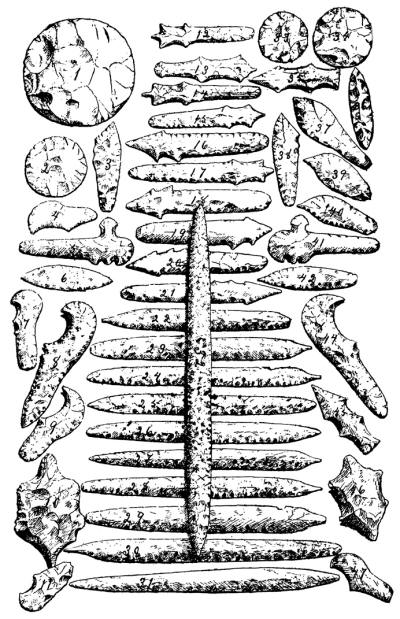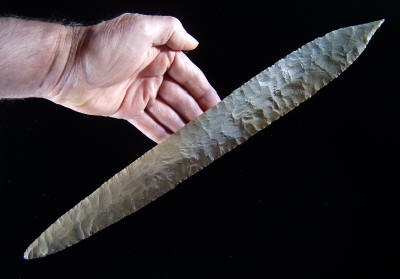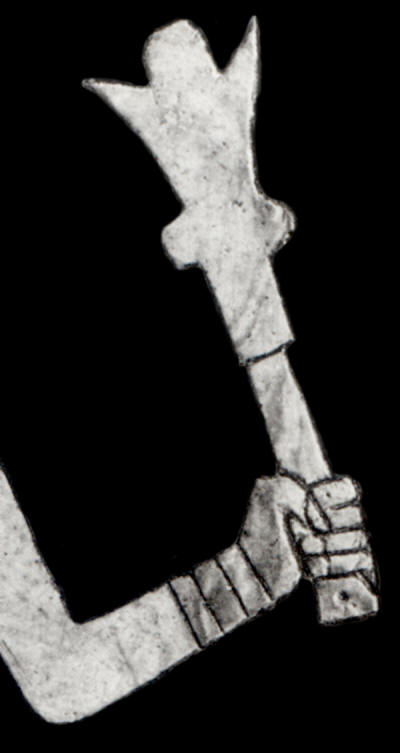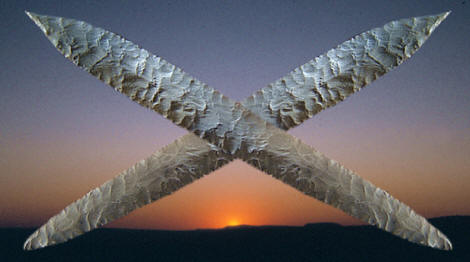|
For more than a hundred years, the Duck River Cache artifacts have
been referred to as flint instruments, ceremonial objects, ceremonial
implements, ceremonial flints, effigies and eccentric flint artifacts.
In-other-words the descriptions all agree that the highly stylized
bifaces probably did not have a utilitarian purpose. In fact, there is
no reason to believe they were heavily used for any purpose. They
apparently weren't resharpened from use and they show no heavy use wear
along the cutting edges. An interesting note, in Seever's description of
the cache in 1897 he writes, "by ceremonial one usually means that no
more questions should be asked."
|
|

CLICK ON PICTURE FOR LARGER IMAGE
DRAWING FROM 1897 "THE ANTIQUARIAN"
DUCK RIVER CACHE OF 46 ARTIFACTS
HUMPHREYS COUNTY, TENNESSEE
FRANK H. McCLUNG MUSEUM
COLLECTIONS
(THE UNIVERSITY OF TENNESSEE)
This drawing is taken from Seever's 1897 description of the Duck
River cache and illustrates all 46 of the flaked stone artifacts. In
the late 1800's the cache was described as the "greatest
single archaeological find ever made in the United States." The
"swords" were described as "----the finest examples of flint
chipping that have been discovered in North America and, possibly in
the world." Even today they stand alone as a testimony to the
ability of the flintknapper's skill that made them. The longest
"sword" in the center measures 28 inches (71.1 cm) long.
One observation concerning the different shapes that make up
the cache is that several of them are represented in pairs. Some of
these pairs are 1 & 2, 3 & 38, 4 & 11, 5 & 41, 6 & 42, 8 & 44, 9 &
47, 10 & 46, 35 & 45, 39 & 40, 12 & 14, 13 & 15, 18 & 19 and 20 &
21.
One thing that is curious
about this cache is the state of preservation of the artifacts. None
of them are broken and yet they were discovered during cultivation
and recovered by people untrained in the scientific technique of
excavation. It might be logical to assume that other damaged
examples might have been found but discarded. |
|
|
A possible insight into the purpose of
the Duck River Cache might be suggested from historical accounts from
"upper California Indians." An early collector by the name of Horatio N.
Rust, from South Pasadena, in the late 1800's, described how he acquired
some of the large bifaces from Indians in northern California and why
some individuals would not part with them. He writes that, "One Indian
told me that their purpose was to indicate official positions in the
tribe, (as an) insignia of authority. Another said they had peculiar
significance in certain ceremonies and dances. Still another informed me
that they marked a certain standard of wealth, or importance in their
tribal organization." He gives a comment made by the last described
Indian, "I no sell him. Now I am rich Indian; if I sell him I am poor
devil." He goes on to say that this Indian sold it anyway, when he promised not to tell anyone
about the sale. |
|

DUCK RIVER STYLE "SWORDS"
(CAST)
MOUND C
ETOWAH MOUNDS SITE
BARTOW COUNTY, GEORGIA
GEORGIA
DEPARTMENT OF NATURAL RESOURCES COLLECTION
by Larry Conrad
This large Mississippian flint "sword" was excavated by Lewis
Larson, PhD in the 1950's from Mound C at the Etowah Mounds site in
Bartow County, Georgia. The "sword" was found in association with a
single adult individual of undeterminate sex in a primary burial-pit
grave which was oriented east-west and flexed on the right side.
This specimen lay at the feet of the individual along with one other
complete and one fragmentary "sword." Also in association with the
burial were two conch shell bowls at the foot of the grave, copper
hair ornaments, a wooden hafted copper celt, small mica crosses in
the area of the flint "swords and small tubular shell beads around
the ankles and below the individuals knees. Two types of cloth lay
over the copper hair ornaments which in turn lay over the skull and
formed a headdress.
This "sword," as well as most bifaces of this type, is made of
Dover chert from Humphreys County, Tennessee. Dover chert ranges in
color from brown to black. This biface measures 16 inches long and 1
11/16 inches wide. |
|
|
Rust comments further about the
large California bifaces that, "I
was assured that they (large bifaces) were not weapons and never used as
such. I was also informed that in some instances they were the common
property of the tribe; and that in other cases, they were hereditary
property of certain families." He also describes two of the bifaces
that, "had strips of cloth firmly fastened around them, terminating in
loops to go around the wrist, to guard against their falling and
probably breaking which indicated their employment in the wild
gesticulations of their dances." He says the bifaces were always kept
hidden away and that sometimes they were lost when the person who hid
them suddenly died. He mentions one account, "I was told of one (biface)
two feet in length that had been lost in this way, and the closet search
of the whole tribe for some years failed to discover it." |
|

ENGRAVING FROM SHELL
GORGET
HIXTON SITE
HAMILTON COUNTY, TENNESSEE
This illustration is taken from a small portion of an engraved shell
gorget that was found on the Hixton site in Hamilton County,
Tennessee. The gorget shows two highly costumed "dancers," with
objects in their hands, who are facing each other. The objects held
in the hands are described by Madeline Kneberg as "a long blade of
the Duck River Cache type and in the other hand a crescent shaped
object which represents the type of eagle claw mace in the Duck
River Cache." This rare engraving offers some insight into the use
of these "exotic" objects. It explains how they were held and may
have been used in some type of ritual event.
Other references to the uses of "exotic" objects, that might
relate in some ways to the purpose of the bifaces in the Duck River
Cache, can be found in oral descriptions of the large
bifaces from northern
California. Another reference for "exotic" stone artifacts that
might relate in some ways to the California or Duck River Cache
bifaces can be found with the
New Guinea Je stones.
Other sources to look at might be the ritual uses of
large Aztec bifaces
from Mexico, large Mayan
bifaces, Ramey knives
and painted Ramey
knives. |
|
|
Another way "ceremonial" artifacts can be interpreted, other than from
an oral history, is from engravings, petroglyphs, rock paintings and
ceramics. Engraved shell gorgets have provided the best insight into how
some of the Duck River Cache artifacts may have been used. Scenes of
dancing or fighting individuals are shown holding different forms of
bifaces such as "swords," maces and eagle claw effigies. These images
may portray similar conceptual uses in ritual events that early descriptions of large
California bifaces have also been recorded, but from oral accounts. |
|

ENGRAVING FROM SHELL
GORGET
SUMNER COUNTY TENNESSEE
This illustration is taken from a small portion of an engraved shell
gorget from Sumner County, Tennessee. The gorget is engraved with a
costumed individual that is holding a severed head in one hand and a
mace in the other. The design of the mace is not two dissimilar from
two examples in the Duck River cache. |
|
|
The Duck River Cache is an extraordinary collection of important
objects. No one may ever know their exact purpose but there is no doubt they
well continue to impress anyone that can see them. The largest bifaces
in the cache exhibit a very high degree of craftsmanship. They establish
an impressive level of flintknapping skill for the time in which they
were made. Very few bifaces over 24 inches have ever been recorded from
prehistoric sites anywhere in the world. |
|
"REFERENCES"
1897, Sever, William
J., The Antiquarian, "A
Cache Of Idols And Chipped Flint Instruments In Tennessee," pp.
141-145.
1897, Rust, Horatio
N., The Antiquarian, "Survivals
Of The Stone Age, And Evolution Of Certain Stone Implements," pp.
284-287.
1972, Compton, Carl B.,
Ten Years Of The Tennessee Archaeologist Selected Subjects, Vol. II, "
Duck River And Similar Artifacts," pp. 196-201.
1972, Kneberg, Madeline, Ten Years Of The Tennessee
Archaeologist Selected Subjects, Vol. II, " Engraved Shell
Gorgets And Their Associations," pp. 231-269.
1981, Brehm, H. C., "The
History Of The Duck River Cache," Miscellaneous Paper No. 6,
Tennessee Anthropological Association, pp. 1-24.
1992, Gramly, Richard Michael, Prehistoric Lithic Industry At
Dover, Tennessee, pp. 1 & 2.
2003, McClung Museum Website,
"Archaeology And The Native Peoples Of Tennessee."
1980's,
Personal communications with Larry Conrad.
The Tennessee Encyclopedia Of History And Culture, web site
|
|
RECENT
LISTINGS HOME
ORDERING |




